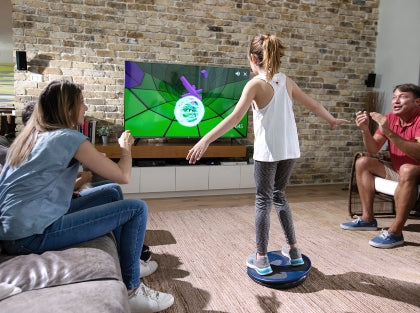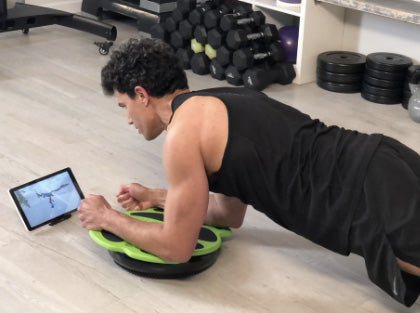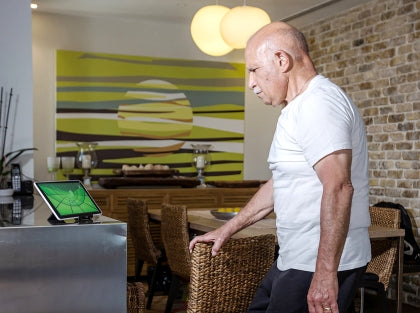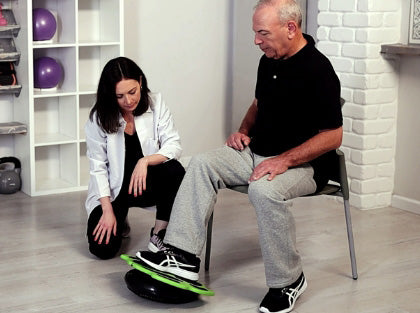Static vs. Dynamic Balance Boards

When it comes to measured improvements in fitness, strength, balance, and recovery, dynamic balance boards have much more supporting evidence than their static counterparts.
Although both pieces of equipment fall into the same general category, the differences between them are numerous. Static and dynamic boards do not share the same initial design purpose. You also physically use each type of board in a specific way and achieve different goals with each.
What are the Types of Balance Boards?
You can divide balance boards into two main camps: static (stationary while in use) and dynamic (boards that move or wobble). These two terms also describe the ways in which our bodies balance.
What Are Static and Dynamic Balance Boards Used For?
Intended use
The most popular static balance board (the WiiFit) was designed to improve basic fitness and overall wellbeing. The basic idea of it is to get families exercising together. Other static balance boards tend to be geared towards fitness, too.
Dynamic boards have various uses, including fitness and wellbeing, but extending to balance mastery, rehabilitation and recovery, injury prevention, physiotherapy, and athletic training.
Fitness
Despite fitness being the primary purpose of a static board, some critics argue that there is a lack of intensity in the workouts that you can do on one. The consensus among both consumers and experts is that it can help to improve your fitness to a certain extent. It is most effective if you live a very sedentary lifestyle to begin with. Then, it can help to increase your physical activity and contribute to better overall fitness.
As common sense would tell us, you can achieve only so much on a static balance board because you are, naturally, standing still (or relatively so). The movement you make is shifting your weight from leg to leg. When considering the medical applications of a static board, it may be beneficial for patients of a low functioning level but would not qualify as a physiotherapy tool.
Dynamic balance boards also have the ability to improve your fitness as a whole. However, they can specifically train different areas of the body and improve other skills and qualities. For example, the Bobo balance board has been clinically proven to increase strength, flexibility, anticipation, endurance, agility, coordination, focus, and control.
The thing that makes a dynamic board like Bobo so much more effective in physically training your body is its movement. Bobo balance boards utilise the existing concept of training on an unstable surface, which means you must actively engage your core muscles to stay balanced. This makes for a more strenuous workout and thus has greater potential for improving fitness.
Balance
Due to their stoic nature, static balance boards are just about as effective at improving your balance as alternative exercise programs. A review of several studies that compared Wii training to regular balance training showed just that.
Dynamic boards like Bobo Home and Bobo Pro challenge your body’s balance in a whole different way. The extra movement you need to maintain stability on a Bobo balance board results in a much more effective training program.
Because Bobo is both a dynamic and electronic balance board, there are on-screen instructions to guide you through each exercise. This means you can execute the movements more precisely, which is another factor that lends to Bobo’s efficacy. Many studies have concluded that electronic balance boards are more effective in improving balance than conventional balance exercises.
Performance training
While static balance boards can be fun for low-level activity, they don’t have much value in the athletic world. The exercises available in a product like the Wii Fit balance board don’t cater to more sporty people, least of all professional athletes.
In start contrast, wobble boards are a standard piece of equipment for any seasoned athlete. And, not just for the first sports that spring to mind, either (like gymnastics, equestrian sports, surfing, skating, etc.) Balance is a vital component of health and fitness and dramatically influences how you move, essentially your sporting ability. You also improve other critical athletic qualities like endurance, coordination, flexibility, and strength when you train with Bobo.
Physiotherapy
There are cases of static balance boards being used in nursing homes to improve the balance, posture, and activity levels of the elderly. When the WiiFit was released, it was also used trialled for physiotherapy rehabilitation and gaming rehabilitation. Unfortunately, a static balance board’s applications in these areas is limited.
Fortunately, there are now purpose-designed products on the market that are proven to be a successful in all sorts of physiotherapy. The Bobo balance board is effective across a range of therapies: proprioception, vestibular, musculoskeletal, neurological, pediatric, sports, and rehabilitation.
Training with Bobo increases recovery times and helps to prevent future injuries. This is a valuable benefit for anyone from the fittest athlete through to the frail and elderly. Bobo has revolutionized the field of physiotherapy by merging otherwise boring training exercises with exciting videogames. This vastly increases patient engagement and motivation, as reported by healthcare professionals around the world who currently use Bobo in their clinic.
Which Type of Balance Board is the Best for Me?
If we make a direct comparison, dynamic boards have more uses and are more effective in helping to achieve your fitness goals.
If you like the idea of the health benefits that a dynamic balance board offers, but are tempted by the gaming aspect of an electronic static board, the Bobo balance board is the perfect synergy of both worlds. You can get professional quality balance-based training that brings your body real results and enjoy a fun video gaming experience at the same time.
















Leave a comment